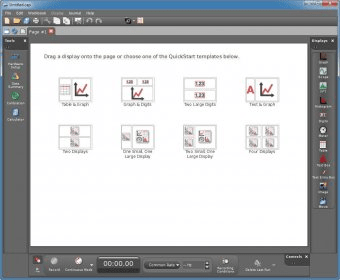

The sphere is now uncharged so you will need to start over, recharging the rod and repeating the process.
Pasco capstone log axis crack#
Note: If you hear a crack or pop sound while the rod is close to the sphere, this means that they were too close to each other and charge jumped across the gap. The sphere on the guide block should now be charged. After you have removed your finger from the sphere pull the sphere away from the charged rod. (When you touch it, you are acting as a ground, a path for electrons to move along.) While the rod is close to the sphere, touch the sphere with your finger and then remove your finger. Bring the charged rod to about ½ cm away from the sphere but do not touch them together. Rub the wool square on the plastic rod to transfer charge to the rod. Stand up the guide block so the sphere is at the top. The order of the steps is critical to success! Check out Figure 2 to help you visualize the steps. Unfortunately, this static charge won’t stick around forever, it will dissipate into the air (this could take seconds to minutes depending on the humidity) so be sure to read through and follow the charging procedure carefully.Ī) Inductively charge the sphere attached to the left guide block by doing the following. In this experiment, we’ll charge a plastic rod using friction, and then transfer the charge to metal-coated Styrofoam spheres.

Become familiar with static charge and how it is transferred.Along the way, we will see a few interesting effects that arise from the accumulation of static charge. Finally, we will use Equation 1 to determine the amount of charge (in Coulombs) that we can generate with static electricity. Second, we will look at how the magnitude and sign of the charges affects the force. First, we’ll measure the force as a function of distance, and see how well it fits the inverse square relationship. In this lab, we will move charges around to set up a test of Coulomb’s law on a simple electroscope. It is important to remember that charge is conserved: we can physically move it around, but we can neither create nor destroy it. Experimental setup showing the electroscope chamber with a suspended sphere, two guide blocks with spheres, and materials for charging the spheres. The direction of the force in this special case is always along a straight line drawn between the two charges.įigure 1.

m2/C2), and are the charges on point charges 1 and 2, respectively and is the distance between the two charges.Where is the Coulomb constant (8.988 109 N Through careful observation of the magnitude of this force, Charles-Augustin de Coulomb discovered an inverse square law relating the force between two charges to the distance between them It is commonly understood that like charges repel, and opposites attract, but the strength of this force (be it attractive or repulsive) also depends on the distance between the two charges.


 0 kommentar(er)
0 kommentar(er)
